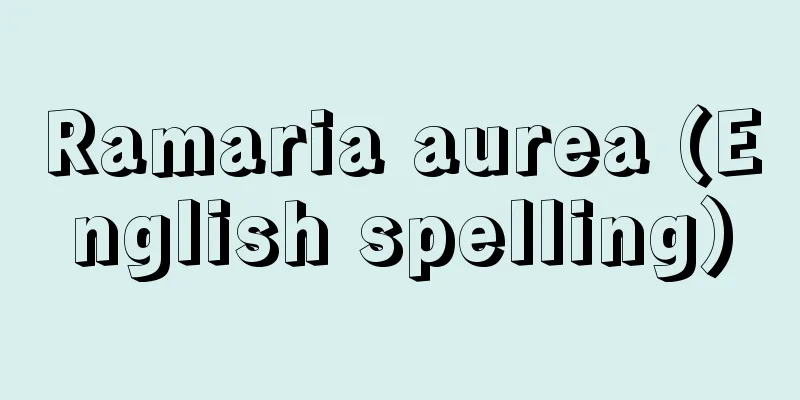School library - gakko toshokan

|
A library is a facility in elementary, junior high, and high schools that collects, organizes, and preserves books and other materials such as printed matter (newspapers, magazines, pamphlets, postcards, etc.), audiovisual materials (records, slides, film reels, photographs, audiotapes, videotapes), electronic materials (CD-ROMs, DVDs, e-books, external databases, various electronic media including video and film), and others (rubbings, specimens, etc.) for use by students and teachers. Its purpose is to contribute to the development of the school's educational curriculum and to foster a sound education in students. The establishment of a library is mandated by the School Library Act (Act No. 185 of 1953). [Motegi Yukio] School Library ActivitiesLibrary staff are involved in volunteer activities such as browsing, lending, reference work (assisting students who wish to use library materials for information gathering or research), copying materials, public relations activities, reading groups, and lectures. They also provide reading guidance and instruction on how to use the library and library materials. Reading guidance aims to improve the reading environment for students, stimulate their desire and interest in reading, teach them reading skills, and through reading, help them accumulate knowledge and develop their character, thereby helping them to become people who can adapt to society. Instruction on usage aims to help students acquire the necessary knowledge and skills for using libraries and library materials, and to provide guidance so that they can carry out independent study by researching, thinking, and solving problems on their own. [Motegi Yukio] historyThe collapse of the Edo Shogunate in 1867 (Keio 3) brought about major changes in society, and after the return of the domains and people to the Emperor (1869) and the abolition of the domains and establishment of prefectures (1871), over 250 domains disappeared. The domain schools, which were educational institutions for the domain's samurai that had been established and run by each domain, were also dissolved. It seems that many of the domain school books were dispersed during the Meiji period, but some were transferred to local libraries and schools. For example, Annaka Domain Zoshikan transferred its books to Annaka Elementary School (Gunma Prefecture), Kuroba Domain Sakushinkan transferred its books to Kuroba Elementary School (Tochigi Prefecture), Sakura Domain Seitoku Shoin transferred its books to Sakura High School (Chiba Prefecture), Hikone Domain Kodokan transferred its books to Hikone Higashi High School (Shiga Prefecture), and Omura Domain Gokyokan transferred its books to Omura First High School (Nagasaki Prefecture). It is believed that the books of the former domain schools were used as school libraries at these schools (high schools were former junior high schools at the time). In addition to these, there were libraries (or reading rooms) attached to elementary schools and old-system junior high schools all over the country. In 1906 (Meiji 39), there were 281 junior high schools, including national, public, and private schools, but at the end of the Meiji period, there were more than 50 libraries attached to junior high schools. During the Taisho era, when the liberal education movement became popular, reading instruction and library usage instruction were also actively carried out, supported by the enthusiasm of teachers in the field of education. Reading instruction was carried out as part of educational activities, and due to this necessity, libraries that could collect and utilize many books were established in elementary and secondary schools during the Taisho era. Examples include the private Seijo Elementary School in Tokyo, which respected the individuality and spontaneity of children and students and tried to guarantee their freedom and autonomy as much as possible, and the Chiba Normal School Attached Elementary School, which encouraged reading by allowing students to freely allocate time regardless of grade, using various teaching materials other than textbooks, and setting up free study time.In addition, many schools have established libraries, including the private Seikei Elementary School in Tokyo, Ikebukuro Children's Village Elementary School, and Jiyu Gakuen, as well as the attached elementary schools of the public Nara Women's Higher Normal School, Akashi Women's Normal School, Tokyo Higher Normal School, and Tokyo Women's Higher Normal School, Kurashiki Elementary School (Okayama Prefecture), Taisha Junior High School (Shimane Prefecture), and Miyoshi Girls' High School (Tokushima Prefecture). Changes after World War IIAfter the end of the Second World War in 1945, the General Headquarters of the Supreme Commander for the Allied Powers (GHQ) promoted the liberalization of education as part of the occupation policy. On March 31, 1947, the Fundamental Law of Education, the School Education Law, the Board of Education Law, etc. were enacted based on the educational philosophy in accordance with the Constitution of Japan, and the publicly elected Board of Education was born. The education system was also transformed to one that included the participation of local governments, schools, teachers, and residents. Various learning materials were needed for the orientation toward independent learning development and for newly started classes, and there was a growing momentum to create and improve school libraries and to revitalize their activities. In 1948, the School Library Handbook was published, and the following year, in 1949, representatives from each prefecture were gathered in two locations in the east and west (Kamogawa City, Chiba Prefecture, and Tenri City, Nara Prefecture) to convey the Handbook and hold training sessions to promote the creation of school libraries throughout the country. In 1950, the National School Library Association (SLA) was formed, the first National School Library Research Conference was held at Hikawa Elementary School in Tokyo, and the journal "School Library" was launched. This was a landmark event in the history of school libraries. The School Library Law was enacted in 1953 against the backdrop of a petition to the Diet with one million signatures calling for the establishment of libraries in all schools and public guarantees to raise them to a certain standard (at the time, 50% of elementary and junior high schools had libraries, and 87% of high schools). The law stipulates the obligation to establish school libraries, the institutionalization of teacher librarians, and public funding for library expenses. In 1958 (Showa 33), the revised curriculum guidelines placed emphasis on improving basic academic ability and education according to ability and aptitude. On the other hand, the sudden increase in the number of children and students made it difficult to enter higher education, and textbook-based knowledge-injection education was resurrected. Furthermore, due to a shortage of classrooms, libraries were being converted into general classrooms in many places, and the school library movement began to show signs of decline. Nevertheless, enthusiastic teachers all over the country continued to accumulate results from their research and activities. From the mid-1950s, the phrase "school library as resource center" was used, and research and practice on library management of audiovisual materials, merging audiovisual departments with libraries, and collecting and organizing file materials became more and more common. In 1978, the curriculum guidelines were revised with the aim of providing "relaxed education" through the careful selection of teaching materials and a reduction in the number of class hours, and in 1980, a new curriculum calling for "relaxed and fulfilling education" was implemented. At the time of this revision, the National School Library Council requested that the educational significance and function of school libraries be clearly stated, one hour per week be set aside for "library time," and one hour be set aside for "independent study time" every day. Manga has long been a popular print medium among children, and in 1980, the combined circulation of the new year's issue of five weekly boys' manga magazines exceeded 10 million copies. Educational manga, such as the "Manga Japanese History" series, were published one after another and became widely popular among elementary and junior high school students. In response to this situation, school libraries were forced to respond to the issue of accepting manga books. In 1986, the National School Library Council launched the "Manga Committee," which continued to consider the issue, and on October 1, 1988, revised the "School Library Book Selection Criteria" to include criteria for manga. Previously, manga was not actively recommended, but it came to be recognized as a cultural asset and valued as something useful for learning and entertainment. In the 1990s, children began to lose interest in reading even more. Concerned about this situation, in 1993, the National School Library Council, the Japan Children's Book Publishers Association and others called for the launch of the "Children and Books Association," with the participation of many organizations, including library associations, authors, artists and publishers. This movement also spread to the political world, and the "Parliamentary League for Children and Books" was established. Activities to promote children's reading began to attract public attention, and in 1995, the cost of establishing a national "International Children's Library (provisional name)" was included in the fiscal year budget. After various events, the library was fully opened on May 5, 2002. The Importance of School Libraries In 1996, the Central Council for Education stated the importance of school libraries in its report "The State of Education in Japan with a View to the 21st Century" as follows: "Among school facilities, school libraries in particular play an indispensable role in school education, and we would like to point out that in addition to improving their book stock, school libraries must also be equipped with a variety of software and information devices, and their function as learning information centers in this advanced information and communications society must be enhanced. Furthermore, the role of school librarians, who are expected to play a central role in the operation of school libraries, is expected to become increasingly important, and it is hoped that their training will be improved and enhanced to accommodate social changes such as the information society, and that the appointment of school librarians will be promoted." As of 2008, 52.2% of elementary schools, 43% of junior high schools, and 78.5% of high schools nationwide had a school librarian. However, schools with 11 classes or less, which are "schools below the size specified by government ordinance," have been deferred "for the time being." According to the 5th School Reading Survey conducted by the National School Library Council in 2009, the average number of books read in May of that year was 8.6 for elementary school students (about 30% of all students read 10 or more books), 3.7 for junior high school students, and 1.7 for high school students. More than 80% of high school students read two books or less (12.6% read two books, 22.7% read one book, and 47.7% read none). This statistic shows a slight upward trend compared to around 1990, when there were concerns that people were losing interest in reading. Movements to improve the reading environment include the "Children's Reading Year" (2000), the enactment of the "Act on the Promotion of Children's Reading Activities" (Act No. 154 of 2001) (2001), the full opening of the International Children's Library (2002), the enactment of the "Letter and Print Culture Promotion Act" (Act No. 91 of 2005) (2005), and the "National Reading Year" (2010). Additionally, "Morning Reading Campaigns," in which all schools simultaneously set aside time to read, have become popular in schools all over the country. The number of schools implementing "morning reading" programs was over 7,000 in 2001, and has grown to over 10,000 in the following years. School Library NetworkAs we enter an advanced information society, libraries are introducing computer networks, improving information software, building databases, making wider use of book materials, and promoting cooperation between libraries. In addition to their traditional role as reading centers, school libraries are also being asked to function as learning centers that support more advanced learning developments, and networking is progressing through collaboration between school libraries. For example, when a single school library is unable to handle the situation on its own, a network is formed that links each school library in the area, with the School Library Support Center at its core. The support center provides services such as managing and operating the network, providing guidance and advice, and interlibrary loan and collection and delivery of materials between libraries. Ichikawa City in Chiba Prefecture was one of the first to tackle reading education and the networking of school libraries around 1990, and was designated by the Ministry of Education, Culture, Sports, Science and Technology as a "model region for sharing school library resources" and "school library support center promotion project." The city's network includes elementary and junior high schools, support schools, kindergartens, and high schools, and Ichikawa City Central Library serves as the support center. The collections of the central library and each school are databased, and they can be searched mutually over the Internet. Necessary books are collected and delivered, and interlibrary loans are made, so that they can be easily borrowed and read from other places. With this system, the number of books transferred annually is said to be as much as 50,000. In addition, cooperation and networking between school libraries and public libraries is also being promoted. Local library networks such as these, including school libraries, are expanding all over Japan. In Gunma Prefecture, the Gunma Prefectural Library is the central administrator of the prefecture's library information network, with 40 public libraries, 18 community center libraries, 17 university libraries, 45 high school libraries, and 2 other specialized libraries participating in the network, and book collection data can be searched via the Internet, and interlibrary loans are possible (as of August 2010). [Motegi Yukio] Open to the communitySchool libraries are being opened to the public all over the country. For example, in Kobe City, the program began in 1969, and by March 1985, the number of schools had reached 50, and by September 2008, the number was at 88. The purpose of the program is to "open libraries in schools designated by the Board of Education to the public, respond to the desire to read among citizens and children and students, and contribute to the healthy development of the local community," and the libraries are open to the general public. In Sapporo City, school libraries began opening to the public in 1978, and by March 1985, the number had reached 21, and as of February 2010, the number was at 93. The number of schools opening to the public is also increasing, and it is hoped that school libraries will play a role as reading centers and information learning centers, in conjunction with the development of a lifelong learning system, and as a place where local people can actively participate. [Motegi Yukio] "Modern School Library Encyclopedia" edited by Tsuneyoshi Fukagawa, Takehiko Kitajima, and Makoto Seto (1982, Gyosei) ▽ "New School Library Science vol. 1-5" edited and published by the National School Library Council (2000-06) ▽ "50 Years of School Libraries" edited and published by the National School Library Council (2004) ▽ "The Future Role of School Libraries and School Librarians: Towards Promoting Allocation and Legislation" edited and published by the National School Library Council (2005) ▽ "Takahashi Motoo and Horikawa Teruyo, "Learning Instruction and School Libraries," revised edition (2005, published by the University of the Air Foundation and the Japan Broadcasting Publishing Association)" ▽ "Takawashi Tadami and Shihota Tsutomu, "The Composition of School Library Media," revised edition (2005, published by the University of the Air Foundation and the Japan Broadcasting Publishing Association)" ▽ "Series: What School Libraries Should Do Now," 6 volumes (2005, Poplar Publishing)" ▽ "The Use of Newspapers in School Libraries" by Hisayo Mikami (2006, National School Library Council) " ▽ "School Libraries that Change Education" edited by Noboru Shiomi (2006, Kazama Shobo) [Reference items] | | | |Source: Shogakukan Encyclopedia Nipponica About Encyclopedia Nipponica Information | Legend |
|
小・中・高等学校において、図書、図書以外の資料――印刷物(新聞、雑誌、パンフレット、絵葉書等)、視聴覚資料(レコード、スライド、映画フィルム、写真、録音テープ、ビデオテープ)、電子資料(CD-ROM、DVD、電子書籍、外部データベース、映像・動画を含むさまざまな電子メディア等)、その他(拓本、標本等)を収集し、整理し、保存して、児童・生徒または教員の利用に供する設備である。その目的は、学校の教育課程の展開に寄与し、児童・生徒の健全な教養を育成することにある。設置については、学校図書館法(昭和28年法律第185号)によって義務づけられている。 [茂木幸雄] 学校図書館活動閲覧、貸出し、レファレンス・ワークreference work(情報の収集、または調査研究のため、図書館資料を利用しようとする児童・生徒に対する援助)、資料複写、広報活動、読書会、講演会等の奉仕活動を行う。さらに、読書指導、図書館および図書館資料の利用指導も行う。読書指導は、児童・生徒の読書環境を整備し、読書意欲・興味をおこさせ、読書技術を学ばせ、読書を通じて、知識を蓄え、人格を陶冶(とうや)して、社会に適応できる人間形成ができるよう、援助することである。また利用指導は、図書館や図書館の資料の利用について必要な知識や技能を習得させ、自分で調べ、考え、問題を解決していく自主学習ができるように、指導することである。 [茂木幸雄] 歴史1867年(慶応3)江戸幕府が崩壊し、社会は大きく変わり、版籍奉還(1869)、廃藩置県(1871)を経て、250余りあった藩は消滅した。各藩によって設立、経営されていた藩士の教育機関であった藩学も解散していった。これら藩学の蔵書は、明治時代になり、四散したものもかなりあったようだが、地元の図書館や学校に移管されたものもあった。たとえば、安中(あんなか)藩造士館は安中小学校(群馬県)、黒羽藩作新館は黒羽小学校(栃木県)、佐倉藩成徳書院は佐倉高校(千葉県)、彦根藩弘道館は彦根東高校(滋賀県)、大村藩五教館は大村第一高校(長崎県)へと、その蔵書が移管された。これらの学校(高校は、当時は旧制中学校)では、旧藩学の蔵書が、学校図書館の図書として利用されたと考えられる。このほかにも、当時の小学校や旧制中学校に付設された図書館(あるいは図書室)は全国各地に存在した。1906年(明治39)の中学校数は国・公・私立合わせて281校であったが、明治末期、中学校付設の図書館は、50館余りあった。 大正時代、自由教育運動が盛んになると、読書指導や図書館の利用指導も、教育現場の教師の熱意に支えられ、活発に行われるようになった。教育活動の一環として読書指導が行われ、その必要性から、多くの図書を収集し、活用できる図書館が、初等・中等学校に設けられたのは、大正期のことである。 児童・生徒の個性や自発性を尊重し、その自由や自治をできる限り保障しようとした東京の私立成城(せいじょう)小学校、学年にこだわらず、時間配当を自由にし、教科書以外の各種の教材を活用し、自由学習時間を設けて、読書を奨励した千葉師範附属小学校がその例である。そのほか、東京、私立の成蹊(せいけい)小学校、池袋児童の村小学校、自由学園や、国公立の奈良女子高等師範学校附小、明石(あかし)女子師範附小、東京高等師範学校附小、東京女子高等師範学校附小などの附属小学校、倉敷小学校(岡山県)、大社中学校(島根県)、三好高等女学校(徳島県)など多くの学校が図書館を設けた。 第二次世界大戦後の変遷1945年(昭和20)第二次世界大戦が終結すると、連合国最高司令官総司令部(GHQ)は、占領政策の一環として教育の自由主義化を進めた。1947年3月31日、日本国憲法にのっとった教育理念に基づき、教育基本法、学校教育法、教育委員会法等が制定され、公選制の教育委員会が誕生した。教育体制も、地方・学校・教師・住民の参加を含めた体制へと転換が図られた。自主的な学習展開への志向や新しく始まった授業などのためにも、さまざまな学習資料が必要とされるようになり、そこに、学校図書館をつくり、充実させ、活動内容を活発化させる機運も高まった。1948年(昭和23)『学校図書館の手引』が刊行され、翌1949年、東西2か所(千葉県鴨川(かもがわ)市、奈良県天理市)に各都道府県の代表者を集めて、『手引』の伝達講習会が開かれ、全国各地に学校図書館づくりの動きが促進されることになった。1950年全国学校図書館協議会(SLA)結成、第1回全国学校図書館研究大会が東京・氷川(ひかわ)小学校で開かれ、機関紙『学校図書館』が創刊された。これは学校図書館の歴史のうえで、画期的なことであった。 学校図書館法が制定されたのは、すべての学校に図書館を設け、一定の水準に引き上げるための公的保障を求める100万人署名による国会請願を背景にしたもので、1953年のことである(当時、小・中学校の図書館設置率50%、高校87%)。同法は、学校図書館の設置義務、司書教諭の制度化、図書館費の公費負担を規定している。 1958年(昭和33)、学習指導要領改訂により、基礎学力の向上、能力と適性に応ずる教育が強調されるようになった。一方、児童・生徒数の激増による上級学校への入学難、教科書中心の知識注入教育の復活、さらに、教室不足による図書館の一般教室への転用も各地にみられ、学校図書館運動も陰(かげ)りがみえ始めた。それでも、全国各地の熱心な教師らによって、その研究・活動の成果は積み上げられていった。昭和30年代中ごろから「資料センターとしての学校図書館」ということばが用いられ、視聴覚資料の図書館管理、視聴覚部の図書館への併合、ファイル資料の収集・整理などの実践や研究が盛んになった。 1978年には教材の精選、授業時数の削減などによる「ゆとりある教育」を目ざした学習指導要領の改訂が始まり、1980年から「ゆとりと充実」を唱えた新教育課程が実施される。この改訂に際し、全国学校図書館協議会は、学校図書館の教育的意義と機能の明示、週1時間の「図書館の時間」の設定、毎日1時間の「自学時間」の設定などの要請を行った。 漫画は、以前より、子供たちに高い人気を誇る活字メディアであったが、1980年には少年漫画週刊誌5誌の新年号発行部数が合計1000万部を越えた。「マンガ日本史」シリーズをはじめとする学習漫画も続々と発行され、小・中学生のあいだに広く普及していった。こうした状況を受けて、学校図書館も漫画図書受け入れについて対応せざるをえなくなる。1986年に全国学校図書館協議会が「まんが委員会」を発足、検討を続け、1988年10月1日「学校図書館図書選定基準」を改定し、漫画についての基準を収録した。以前は、漫画を積極的に薦めることはしなかったが、文化財のひとつとして認め、学習や娯楽に役立つものとして評価するようになった。 1990年代になると、子供の読書離れはさらに進むようになった。こうした状況が憂慮され、1993年(平成5)全国学校図書協議会、日本児童図書出版協会等の呼びかけで、図書館協会、作家・画家・出版関係など多くの団体が参加して「子どもと本の出会いの会」が発足した。また、この動きは政界にも広がり、「子どもと本の議員連盟」が設立された。子供の読書を推進しようとする活動は、社会の注目を集めるようになり、1995年には、年度予算に、国立の「国際子ども図書館(仮称)」設立計画の費用が計上された。その後、さまざまな経緯を経て、2002年5月5日に全面開館を迎えるに至った。 学校図書館の重要性1996年、中央教育審議会は「21世紀を展望した我が国の教育の在り方について」の答申で、学校図書館の重要性について、次のように述べている。「学校の施設の中で、特に学校図書館については、学校教育に欠くことのできない役割を果たしているとの認識に立って、図書資料の充実のほか、様々なソフトウェアや情報機器の整備を進め、高度情報通信社会における学習情報センターとしての機能の充実を図っていく必要があることを指摘しておきたい。また、学校図書館の運営の中心となることが期待される司書教諭の役割はますます重要になると考えられ、その養成について、情報化等の社会の変化に対応した改善・充実を図るとともに、司書教諭の設置を進めていくことが望まれる。」 2008年の時点で、全国の小学校52.2%、中学校43%、高等学校78.5%の学校に司書教諭が配置されている。ただし、「政令で定める規模以下の学校」に当たる11学級以下の規模の学校への司書教諭の配置は「当分の間」猶予されている。2009年の全国学校図書館協議会第5回学校読書調査によると、同年5月の1か月間の平均読書冊数は、小学生8.6冊(全生徒の約3割が10冊以上)、中学生3.7冊、高校生1.7冊である。高校生の8割以上が2冊以下(2冊が12.6%、1冊が22.7%、0冊が47.7%)となっている。この統計は、読書離れが危惧されていた1990年ころに比べると、若干上昇傾向にある。読書環境整備の動きとしては「子ども読書年」(2000)、「子どもの読書活動の推進に関する法律」(平成13年法律第154号)の制定(2001)、国際子ども図書館の全面開館(2002)に、「文字・活字文化振興法」(平成17年法律第91号)の制定(2005)、「国民読書年」(2010)などがある。また、全国各地の学校で、全校いっせいに読書の時間を設ける「朝の読書運動」が盛んに行われるようになった。「朝の読書」の実施校は、2001年時で7000余校、その後数年で1万数千校に達した。 学校図書館ネットワーク高度情報化社会を迎え、図書館もコンピュータネットワークの導入や情報ソフトの整備、データベースの構築、図書資料の幅広い活用、図書館間の連携などを進めている。学校図書館も、従来の読書センターとしての役割に加え、より高度な学習展開を支える学習センターとしての機能が求められており、学校図書館の連携によるネットワーク化が進んでいる。たとえば、1か所の学校図書館だけでは対応が難しい場合、学校図書館支援センターを核にして、地域の各学校図書館を結ぶネットワークがある。支援センターは、ネットワークの管理運営、指導や助言、各図書館間の資料の相互貸借・集配などのサービスを提供する。 千葉県市川市では、いち早く1990年ころから読書教育と学校図書館ネットワーク化に取り組み、文部科学省の「学校図書館資源共有型モデル地域」「学校図書館支援センター推進事業」などに指定された。同市のネットワークには、市内の小・中学校、支援学校、幼稚園、高等学校が参加、市川市中央図書館が支援センターの役割を担っている。中央図書館と各校の蔵書がデータベース化され、相互にインターネット検索ができ、必要な図書は、集配、相互貸借され、容易に他所から借りて読むことができる。このシステムで、年間に移動する図書数は5万冊にのぼるという。また、学校図書館と公共図書館等との連携、ネットワーク化も進めている。こうした学校図書館をはじめとする地域の図書館ネットワークは、日本各地に拡大している。群馬県の場合は、群馬県立図書館が県内図書館情報ネットワークの中心となって管理を行い、公立図書館40館、公民館図書室18館、大学図書館17館、高等学校図書館45館、その他専門図書館2館がネットワークに参加し、蔵書データがインターネット検索でき、相互貸借が可能である(2010年8月の時点)。 [茂木幸雄] 地域開放学校図書館の地域開放は全国各地で進められている。たとえば、神戸市では1969年(昭和44)に開始、1985年3月に50校に達し、2008年(平成20)9月時には88校である。趣旨は「教育委員会が指定する学校の図書室を開放し、市民および児童・生徒の読書意欲にこたえ、地域社会の健全な育成に寄与すること」であり、一般の人々に開放されている。札幌市では1978年から学校図書館開放に着手し、1985年3月に21校に達し、2010年2月の時点で93校である。全校的にも増加傾向であり、学校図書館は、生涯学習体制の整備と連動しつつ、読書センター、情報学習センターとして、地域の人々が積極的に活躍する場としての役割を果たしていくことが望まれる。 [茂木幸雄] 『深川恒喜・北嶋武彦・瀬戸真編著『現代学校図書館事典』(1982・ぎょうせい)』▽『全国学校図書館協議会編・刊『新学校図書館学 1~5』(2000~06)』▽『全国学校図書館協議会編・刊『学校図書館50年史』(2004)』▽『全国学校図書館協議会編・刊『これからの学校図書館と学校司書の役割――配置促進と法制化に向けて』(2005)』▽『高橋元夫・堀川照代著『学習指導と学校図書館』改訂版(2005・放送大学教育振興会、日本放送出版協会発売)』▽『高鷲忠美・志保田務著『学校図書館メディアの構成』改訂版(2005・放送大学教育振興会、日本放送出版協会発売)』▽『『シリーズいま、学校図書館のやるべきこと』全6巻(2005・ポプラ社)』▽『三上久代著『学校図書館における新聞の活用』(2006・全国学校図書館協議会)』▽『塩見昇編著『教育を変える学校図書館』(2006・風間書房)』 [参照項目] | | | |出典 小学館 日本大百科全書(ニッポニカ)日本大百科全書(ニッポニカ)について 情報 | 凡例 |
Recommend
Fair, JG (English spelling) FairJG
...In Spanish, it means "good weather,"...
Hunkar Iskelesi (English spelling)
…A treaty of mutual assistance concluded on July ...
God, Grave, Scholar
…He lived in the United States from 1954 until hi...
Phenol - phenol
Compounds in which a hydroxyl group is bonded to ...
Sensor - Sensa (English spelling) sensor
It is an engineering term derived from the Latin ...
Temporary Measures Law on Fines, etc.
This law provisionally stipulated special provisi...
Rudolf von Ems
…He avoided dialectal forms in rhyming, and contr...
Cost of sales - Uriagegenka (English spelling) cost of sales
One of the expenses necessary for a company's ...
Donburi Pond - Dobuike
A pond located in Minamisenba, Chuo Ward, Osaka Ci...
Hypoglossal nerve
The 12th cranial nerve is a purely motor nerve th...
Autumnal orchid - Autumnal orchid
... C . dayanum Reichb.f.var. austro - japonicum ...
Isehama
…Therefore, the name Kabuto-cho is often used as ...
kuladuhitṛ (English spelling) kuladuhitr
...A famous layperson in the Mahayana sutras is V...
Cold Glacier
…Although they are much smaller than continental ...
Citellus beecheyi (English spelling) Citellusbeecheyi
…[Yoshiharu Imaizumi]. … *Some of the terminology...




![Osaki [town] - Osaki](/upload/images/67cb15611c26e.webp)




